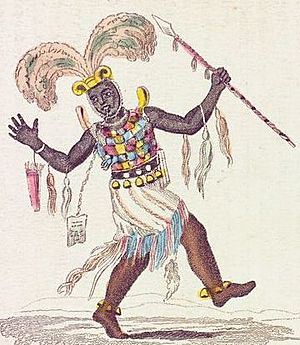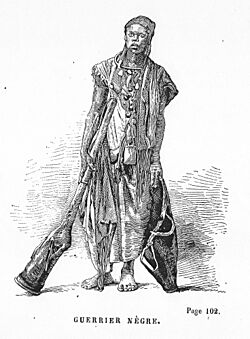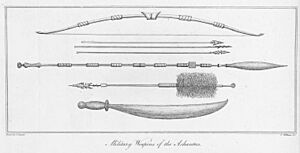Military of the Asante Empire facts for kids
Quick facts for kids Asante army |
|
|---|---|
| Participant in Ashanti–Fante War, the Anglo-Ashanti wars | |

|
|
| Leaders | Asantehene (commander-in-chief) |
| Headquarters | Kumasi |
| Area of operations | Gold Coast, Ivory Coast, Togo, Dahomey |
| Part of | Asante Empire (Ashanti) |
| Allies | The Dutch, Akwamu |
| Opponents | Denkyira, Fante Confederacy, Ga-Adangbe alliances, Akyem, Kingdom of Dahomey, the Danes and British Empire. |
| Battles and wars | Battle of Feyiase, Battle of Nsamankow, Battle of Atakpamé, War of the Golden Stool |
The Asante Empire was a powerful kingdom in what is now Ghana. It existed from 1701 to 1957. The Asante Empire's military was formed around the 17th century. It was created to fight against the Denkyira Kingdom, which had taken control of the Asante people.
This army was the main fighting force of the empire. It continued until the Asante land became a British colony in 1901. In 1701, King Osei Kofi Tutu I led the Asante to freedom. They won a big battle against Denkyira called the Battle of Feyiase. After this, King Osei Tutu I started to expand the empire.
Before the 18th century, the Asante army mainly used bows with poisoned arrows, swords, spears, and javelins. King Osei Tutu I made many changes to the army. He adopted fighting methods from other Akan kingdoms. The Asante also traded with Europeans on the coast. This allowed them to get firearms and cannons. By the 19th century, most soldiers used muskets and rifles.
The army used canoes to travel across rivers. They also had military engineers who helped build things. The Asante army did not use cavalry (soldiers on horses) much, unlike their foot soldiers. To get enough soldiers, they used volunteers and troops from lands they had conquered. They also had a core group of professional soldiers. The Asante developed clever fighting plans, like surrounding the enemy.
Contents
History of the Asante Army
How the Army Began
The Asante people first lived in groups called clans. Each clan was led by a paramount chief. These clans did not have a single, organized army. They were under the control of another Akan state called Denkyira. Denkyira had a lot of power in the region.
In the mid-17th century, the Oyoko clan, an Asante group, started to unite the other clans. Their leader, Chief Nana Oti Akenten, is thought to be the first to bring them together for military strength.
Winning Independence
In the 1670s, Osei Kofi Tutu I became the head of the Oyoko clan. He continued to unite the Akan clans quickly. He used both diplomacy (talking and making agreements) and warfare. Osei Tutu I and his main advisor, Okomfo Anokye, led a group of Asante city-states. They fought against Denkyira.
In 1701, this group defeated Denkyira at the Battle of Feyiase. This victory was a huge moment. It marked the beginning of the strong Asante state.
King Osei Tutu's Army Changes
Osei Tutu wanted to make the military stronger and more professional. He brought the different Akan states together under one central government. He also made the legal system more powerful. Over time, the small city-states became a unified kingdom and then a large empire. New areas that were conquered could choose to join the Asante Empire or become states that paid tribute.
Osei Tutu focused a lot on how the army was set up. He used ideas from the Akwamu army, who were allies of the Asante. He trained the united army to be a very effective fighting force. Osei Tutu also improved their battle plans. He introduced the pincer formation. In this plan, soldiers attacked the enemy from the left, right, and rear. This formation was later used by many other kingdoms in the area.
The Asante military became weaker after 1901. This happened when the British defeated the empire in the War of the Golden Stool.
How the Asante Army Was Organized
The Asantehene (the king) was the main leader of the Asante military. All Asante citizens over 18 years old paid a special tax for war. This money helped pay for army expenses. The Asante army was divided into six main parts. Each part had smaller groups within it. Their organization was based on local Akan military systems, like the Akwamu army.
The six parts of the Asante army were:
- Scouts (akwansrafo)
- Advance guard (twafo)
- Main body (adonten)
- Personal bodyguard (gyase)
- Rear-guard (kyidom)
- Two wings: left (benkum) and right (nifa). Each wing had two formations.
In battle, the army used these parts to move and fight. This setup allowed Asante generals to move their troops easily. Scouts were professional hunters. They would go ahead to find the enemy. They used their excellent marksmanship to shoot at enemy forces from high in trees. They would also shake trees with long sticks to make the enemy think someone was hiding there. This helped them find the enemy's positions. Scouts would not fight for long. They would retreat when the advanced guards came forward.
The advanced guard could also start the attack or trick the enemy into showing their position. The gyase, or personal guards, protected the king or other important leaders. The rear guard could chase the enemy or act as backup troops. The two wings helped surround the enemy or attack them from behind.
Soldiers were encouraged to be brave. Those who tried to run away were stopped by sword-bearers. Asante soldiers had a saying they had to remember: "If I go forward, I die; if I flee, I die. Better to go forward and die in the mouth of battle."
The ankobia, or special police, were like special forces and bodyguards for the Asantehene. They also gathered information to stop rebellions. Horses were brought into the state around the 18th century. However, a full cavalry (soldiers on horseback) was not developed. This was partly because of the tsetse fly in the forest areas, which harmed horses.
Canoes were very important for moving troops across rivers. A British captain once saw Asante troops making an amphibious landing (landing from water) in the late 1800s. He estimated that 12,000 men crossed a river in five days using ferries. The Asante army also had medical teams behind the main forces. These teams cared for the wounded and removed the dead. By the late 19th century, a full-time medical corps (medical branch) was part of the Asante army.
Getting Soldiers and Supplies
The Asante army had a small group of professional fighters. But most of their soldiers were ordinary people, volunteers, and troops from allied or conquered kingdoms. Led by skilled commanders like Osei Tutu, these armies helped expand the Asante empire in the 18th and 19th centuries. By 1820, one British source thought the Asante could send 80,000 troops into battle. About 40,000 of these could have muskets.
Slaves marched behind the main army. They carried supplies on their heads. The army also had carpenters to build shelters and blacksmiths to fix weapons. There were also sutlers who sold food and drinks. Some wives followed their husbands to war to cook for them and provide water during battles. The Great Roads were very important for Asante warfare. These roads allowed the army to move quickly. They also made it harder for enemies to use the forest to their advantage.
Asante Army Equipment
Weapons Used
Before the Asante clans united, their main weapons were bows, shields, and arrows. After defeating Denkyira in 1701, Osei Tutu I started trading with European merchants. This allowed the Asante to get firearms. By the 18th century, the Asante were very familiar with guns. Most Asante soldiers carried various guns, including the common European trade musket, the Long Dane.
Long-barreled muskets helped the Asante win battles. In 1742, the Asante army defeated the Akyem using Dutch muskets with barrels 5-6 feet long. The Akyem's guns had shorter barrels (3-4 feet long). This victory made long-barreled muskets very popular in the region.
Some Asante soldiers had modern British Snider–Enfield rifles. British reports from 1878-1881 estimated that the Asante had between 1,000 and 5,000 modern rifles. They also used 1,000 old French smoothbore muskets. These had been used in the 1814 battle of Waterloo. However, Asante guns were not as good as the best European firearms of the time.
General Nkwanta, a top Asante army leader, studied new European guns in 1872-73. He was worried that Asante muskets were outdated compared to European ones. Good quality gunpowder was also hard to get. Many gunmen did not use wadding to pack the powder tightly. They just dumped it in with lead slugs, nails, metal bits, or even stones. This made a big flash but meant enemies had to be very close to be hit.
Guns and ammunition pouches were carefully protected with leopard or leather covers. Soldiers carried 30 to 40 gunpowder charges. These were packed in small wooden boxes for quick loading. Soldiers also wore buckskin belts with knives and machetes.
Cannons and Artillery
Asante King Kwaku Dua I made a deal to get Dutch cannons. In return, Asante troops would serve in the Royal Netherlands East Indies Army. The Dutch gave the Asante king cannons that were meant for ships, not for moving easily on land. In Kumasi, there was a "Cannon-square" where captured Dutch cannons were kept. These were taken from Denkyira after the Battle of Feyiase.
What Soldiers Wore
Most fighters wore a special shirt called a batakari. It was made with charms and amulets from Dagbon. The Asante believed these charms made them impossible to harm. A writer named Bowdich described a regular soldier in the 19th century:
Their caps were of the skin of pangolin and leopard, the tails hanging down behind; their cartouch belts (composed of small gourds which hold the charges, and covered with leopard or pig's skin) were embossed with red shells, and small brass bells thickly hung to them; on their hips and shoulders was a cluster of knives; iron chains and collars dignified the most daring, who were prouder of them than of gold; their muskets had rests affixed of leopard's skin, and the locks a covering of the same; the sides of their faces were curiously painted in long white streaks and their arms also striped, having the appearance of an armour....
He also described a war captain in 1817:
The dress of the captains was a war cap, with gilded ram horns projecting in front, the sides extended beyond all proportion by immense plumes of eagle feathers, and fastened under the chin with bands of cowries. Their vest was of red cloth, covered with ... saphies in gold and silver; and embroidered cases of almost every colour, which flapped against their bodies as they moved, intermixed with small brass bells , the horns and tails of animals, shells and knives; long leopard tails hung down their backs <...> They wore loose cotton trousers, with immense boots of dull red leather, coming half way up the thigh, and fastened by small chains to their cartouch or waist belts; these were also ornamented with bells, horse tails, strings of amulets, and innumerable shreds of leather; a small quiver of poisoned arrows hung from their right wrist, and they held a long iron chain between their teeth, with a scrap of Moorish writing affixed to the end of it. A small spear was in their left hands, covered with red cloth and silk tassels; their black countenances heightened the effect of this attire, and completed a figure scarcely human....
Some scholars believe the idea that the batakari could stop bullets was due to how inaccurate guns were back then. Also, the leather pouches and metal cases made the war dress look heavy and strong. Another historian, Edgerton, said that the Asante army did not have a single uniform. Soldiers dressed in their own distinct ways.
Asante Battle Tactics
The Asante used flexible battle plans because of the thick forest in West Africa. Large battles with thousands of soldiers in open fields were rare. Asante tactics involved smaller groups, constant movement, ambushes, and scattered attacks.
In one unusual event in 1741, the Asante and Akyem armies agreed to a battle. They even assigned 10,000 men to cut down trees to create an open space for a big fight. The Asante won this battle.
A British report in 1844 said that Asante tactics involved cutting many footpaths in the bush. This allowed them to approach and surround the enemy. The Asante army would form lines and attack when they reached their starting point. Other British accounts describe the Asante army using converging columns. This meant several marching columns would join into one strong attack force. This strategy was also used by Napoleon Bonaparte and the British.
In battle, Asante troops held their guns at the same angle. Then they would turn towards the enemy and fire volleys (many shots at once) when commanded. Scouts would watch the enemy army as it marched. They would then retreat as the enemy got close. When combat began, the advance guard would move forward in 2 or 3 long lines. They would fire their muskets and then reload. The second line would then advance, fire, and reload. A third line would do the same. This "rolling fire" tactic continued until the advance stopped. Flanking maneuvers (attacking from the side) were also part of Asante tactics. Some historians noted that Asante forces could fire from the shoulder. In 1820, Joseph Dupuis wrote that the Asante were "trained to firing with celerity as we ourselves use the musquet."
The Asante also used hammer and anvil tactics in wars, like the Third Anglo-Ashanti War. In 1874, a strong British force led by Sir Garnet Wolseley invaded the Asante Empire. They had modern rifles and cannons. The Asante did not fight them right away. They wanted to draw the British deep into their land. Their plan was to trap the British at a strong defensive point near the town of Amoaful. Here, the British would be held in place, while Asante troops circled around to cut them off.
Historians note that this was a traditional Asante battle strategy. At Amoaful, the Asante successfully lured the British forward. However, they could not stand against the modern British firepower. The British used heavy artillery fire and advanced with infantry in squares. This artillery caused many Asante casualties. But the Asante kept a central force in place and launched a large attack on the British left side. This attack almost surrounded the British line and broke into some of their infantry squares. However, Asante weapons were not as good as the modern British guns.
One British soldier noted:
- "The Ashantees stood admirably, and kept up one of the heaviest fires I ever was under. While opposing our attack with immediately superior numbers, they kept enveloping our left with a constant series of well-directed flank attacks."
Wolseley had expected the Asante's "horseshoe" formations. He had strengthened the British sides with his best units and more firepower. He could move this firepower to threatened areas, stopping the Asante's hammer and anvil attacks. This forced the Asante to retreat. A British report praised the Asante commander, Amanquatia, for his leadership and use of the land:
- "The great Chief Amanquatia was among the killed. Admirable skill was shown in the position selected by Amanquatia, and the determination and generalship he displayed in the defence fully bore out his great reputation as an able tactician and gallant soldier."
Sieges and Engineering Skills
During one siege of a British Fort in the Anglo-Ashanti wars, the Asante used several tactics. They shot at defenders, cut telegraph wires to stop communication, blocked food supplies, and attacked relief columns. The Asante Empire also built strong log stockades (fortifications) at important locations. These were used in later wars against the British to stop their advances. Some of these forts were over a hundred yards long. They had heavy, parallel tree trunks and could not be destroyed by artillery fire.
Behind these stockades, many Asante soldiers were ready to stop enemy movement. While these forts were well-built, many failed because Asante guns, gunpowder, and bullets did not have enough power to stop the enemy for long. British troops overcame or bypassed the stockades by charging with bayonets after firing some shots.
Brass barrel blunderbuss guns were made in some Gold Coast states, including the Asante Empire, in the 18th and 19th centuries. Records show that Asante blacksmiths could repair firearms. They could even remake barrels, locks, and stocks. Besides making guns locally, gunpowder might also have been prepared in Asante.
See also
- African military systems to 1800
- African military systems (1800–1900)
- African military systems after 1900
- Anglo-Ashanti wars
- Ashanti–Fante War
- Ga-Fante War
- Impi
- Katamanso War
- Political systems of the Asante Empire





